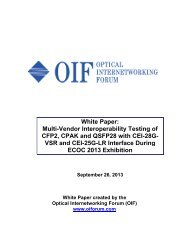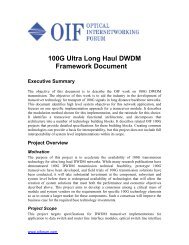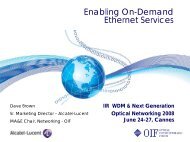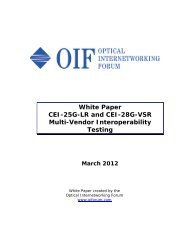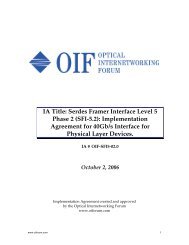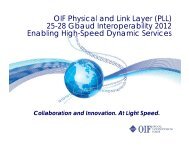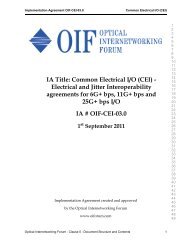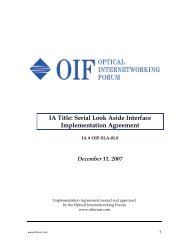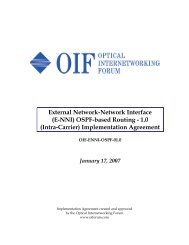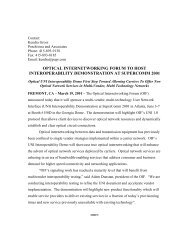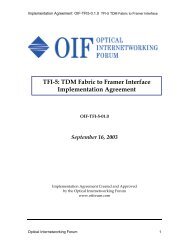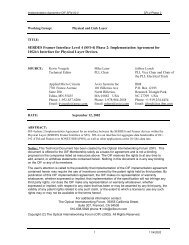OIF Next Generation Interconnect Framework
OIF Next Generation Interconnect Framework
OIF Next Generation Interconnect Framework
You also want an ePaper? Increase the reach of your titles
YUMPU automatically turns print PDFs into web optimized ePapers that Google loves.
<strong>OIF</strong> <strong>Next</strong> <strong>Generation</strong> <strong>Interconnect</strong><strong>Framework</strong><strong>OIF</strong>-FD-Client-400G/1T-01.0April 2013www.oiforum.com 1
Abstract:As the <strong>OIF</strong> looks forward to the higher data rates and/or higher throughput that will be required forthe next generation of systems, a consensus has been reached that new technologies will berequired. This framework document represents the efforts of the <strong>OIF</strong> to identify the hardwareinterconnection application spaces where the communications industry might benefit frominterconnection definitions or “Implementation Agreements” (IA). The objective of this paper is toidentify key technical challenges for next generation systems, define optical and electricalinterconnection applications and discuss some of the interoperability test challenges so that the<strong>OIF</strong> and other industry bodies will have a common language as well as understanding of thedevelopment projects that are required for the next generation data rate systems.<strong>Next</strong> <strong>Generation</strong> <strong>Interconnect</strong> <strong>Framework</strong> Contributors:Document Co‐Editors:Nathan TracyTorsten WuthTE ConnectivityNokia Siemens NetworksIndividual Clause Editors:Robert Brunner (Clause 2) EricssonGraeme Boyd (Clause 3) PMC SierraTom Palkert (Clause 4) MolexBrice Achkir (Clause 5) CiscoAli Ghiasi (Clause 5)BroadcomAlong with the many members of the <strong>OIF</strong> who provided their inputs to this document.The <strong>OIF</strong> is an international non profit organization with over 100 member companies, includingthe world’s leading carriers and vendors. Being an industry group uniting representatives of thedata and optical worlds, <strong>OIF</strong>’s purpose is to accelerate the deployment of interoperable, costeffectiveand robust optical internetworks and their associated technologies. Optical internetworksare data networks composed of routers and data switches interconnected by optical networkingelements.With the goal of promoting worldwide compatibility of optical internetworking products, the <strong>OIF</strong>actively supports and extends the work of national and international standards bodies. Formalliaisons have been established with The ATM Forum, IEEE 802.3, IETF, ITU-T Study Group 13,ITU-T Study Group 15, MEF, NPF, T1M1, T1X1, TMF, UXPi and the XFP MSA Group.For additional information contact:The Optical Internetworking Forum, 39355 California Street,Suite 307, Fremont, CA 94538510-608-5928 Φ info@oiforum.comwww.oiforum.comwww.oiforum.com 2
Table of ContentsContentsGlossary † ......................................................................................................................................... 51 Executive Summary ................................................................................................................. 72 Introduction ............................................................................................................................... 82.1 Purpose ............................................................................................................................. 82.2 Motivation .......................................................................................................................... 92.2.1 Challenges of Power Dissipation ............................................................................. 122.2.2 Challenges of I/O Densities on Chips and Connectors ........................................... 122.2.3 Challenges of Channel Characteristics .................................................................... 132.2.4 Challenges of Electrical Link Reach ........................................................................ 132.3 Summary ......................................................................................................................... 143 <strong>Interconnect</strong> Applications ....................................................................................................... 153.1 Die to Die <strong>Interconnect</strong> Within A Package ...................................................................... 153.2 Die to optical engine within a package ............................................................................ 163.3 Chip to Nearby Optical Engine ........................................................................................ 163.4 Chip to Module ................................................................................................................ 173.5 Chip to Chip within PCBA ............................................................................................... 173.6 PCBA to PCBA across a Backplane/Midplane ............................................................... 183.7 Chassis to Chassis within a Rack ................................................................................... 193.8 Rack to Rack side-by-side .............................................................................................. 193.9 Rack to Rack in the same row ........................................................................................ 203.10 Rack to Rack in the same building .............................................................................. 213.11 Rack to Rack in the same data warehouse ................................................................. 223.12 Rack to Rack in the same campus .............................................................................. 233.13 Longer than 2km links ................................................................................................. 233.14 <strong>Interconnect</strong> Application Summary .............................................................................. 234 Points of Interoperability ......................................................................................................... 254.1 Electrical Channel points of interoperability .................................................................... 254.1.1 Die to Die, Chip to Chip, Back/Midplane, Chip to Optical engine interconnects ..... 254.1.2 Chip to module interoperability points ...................................................................... 275 Opportunities for Future Work ................................................................................................ 295.1 Introduction ..................................................................................................................... 295.2 Electrical <strong>Interconnect</strong> ..................................................................................................... 295.2.1 Electrical Connectors ............................................................................................... 295.2.2 Electrical Links ......................................................................................................... 295.3 Optical <strong>Interconnect</strong> ........................................................................................................ 305.3.1 Optical Connectors .................................................................................................. 305.3.2 Optical Links ............................................................................................................ 305.4 Thermal Management ..................................................................................................... 316 Relation to Other Standards ................................................................................................... 327 Summary ................................................................................................................................ 33List of TablesTable 1 Forward Looking Optical 40Tbps Scenarios .................................................................. 10Table 2 Intra-<strong>Interconnect</strong> Applications ....................................................................................... 23Table 3 Inter-<strong>Interconnect</strong> Applications ....................................................................................... 24www.oiforum.com 3
List of FiguresFigure 1 <strong>Interconnect</strong> Application Spaces ..................................................................................... 8Figure 2 Scaling Gates/Bumps/Pins (Ref. Xilinx, I/O Line Added) .............................................. 11Figure 3 <strong>Next</strong> <strong>Generation</strong> <strong>Interconnect</strong> Challenges ..................................................................... 11Figure 4 <strong>Interconnect</strong> Application Spaces .................................................................................... 15Figure 5 Die to Die within an MCM <strong>Interconnect</strong> Application Space ............................................ 15Figure 6 Die to Optical Engine MCM <strong>Interconnect</strong> Application Space ......................................... 16Figure 7 Chip to nearby OE <strong>Interconnect</strong> Application Space ....................................................... 16Figure 8 Chip to Module <strong>Interconnect</strong> Application Space ............................................................ 17Figure 9 Chip to Chip Within PCBA <strong>Interconnect</strong> Application Space ............................................ 17Figure 10 PCBA to PCBA Across a Backplane/Midplane <strong>Interconnect</strong> Application Space ......... 18Figure 11 Chassis to Chassis within the Same Rack <strong>Interconnect</strong> Application Space ................ 19Figure 12 Rack to Rack side-by-side <strong>Interconnect</strong> Application Space ......................................... 19Figure 13 Rack to Rack in the Same Row <strong>Interconnect</strong> Application Space.................................. 20Figure 14 Rack to Rack in the Same Building <strong>Interconnect</strong> Application Space ........................... 21Figure 15 Rack to Rack in the Same Data Warehouse <strong>Interconnect</strong> Application Space ............. 22Figure 16 Rack to Rack in the Same Campus <strong>Interconnect</strong> Application Space .......................... 23Figure 17 <strong>Interconnect</strong> Application Space Showing Points of Interoperability ............................. 25Figure 18 Chip to Chip Interop Points .......................................................................................... 26Figure 19 Backplane/Midplane Interoperability Point ................................................................... 26Figure 20 Pluggable Modules on Front Faceplate ....................................................................... 27Figure 21 Chip to Module Interoperability Point ........................................................................... 27www.oiforum.com 4
Glossary †2.5D: Refers to a type of die-to-die integration via a silicon interposer having through-silicon vias (TSVs)connecting its top and bottom metal layers3D: Refers to a three-dimensional (3D) integrated device in which two or more layers of active electroniccomponents (e.g., integrated circuit dies) are integrated vertically into a single circuit where through-siliconvias (TSVs) are commonly used for die-to-die connection.Application Spaces: Portions of equipment or network architecture that could benefit from having a definedset of interconnection parameters.ASIC: An application-specific integrated circuit is an integrated circuit (IC) customized for a particular use,rather than intended for general-purpose use.BCH: BCH forward error correction (FEC) codes form a class of cyclic error-correcting codes that areconstructed using finite fields.BER: Bit Error Ratio is the number of bit errors divided by the total number of transferred bits during astudied time interval.BGA: Ball Grid Array, a package typeCAP: Carrierless amplitude phase modulation is a variant of quadrature amplitude modulation (QAM).Instead of modulating the amplitude of two carrier waves, CAP generates QAM signal by combining twoPAM signals filtered through two filters designed so that their impulse responses form a Hilbert pair.CDR: Clock and data recovery, a component that re-establishes the timing of a signal that may havedegraded due to impairments on a transmission line, the retimed signal is now able to continue further to it’sdestination.CEI: Common Electrical Interface, an <strong>OIF</strong> Implementation Agreement containing clauses defining electricalinterface specifications.DMT: Discrete multi-tone modulation, example: OFDM is a form of DMT.EMB: Effective modal bandwidth, see TIA-492AAAD.FEC: Forward error correction gives a receiver the ability to correct errors without needing a reverse channelto request retransmission of data.FR4: A grade designation assigned to glass-reinforced epoxy printed circuit boards (PCB).Gb/s: Gigabits per second. The stated throughput or data rate of a port or piece of equipment. Gb/s is1x10 9 bits per second.GBd: The baud rate is the actual number of electrical transitions per second, also called symbol rate.GigaBaud is 1x10 9 symbols per second.IA: Implementation Agreements, what the <strong>OIF</strong> names their defined interface specifications.IC: Integrated CircuitI/O: Input Output, a common name for describing a port or ports on equipmentMCF: Multi core fiber is a single glass fiber with multiple individual single mode cores to enable higherdensities.www.oiforum.com 5
MCM: Multi chip module, a specialized electronic package where multiple integrated circuits (ICs),semiconductor dies or other discrete components are packaged onto a unifying substrate, facilitating theiruse as a single component (as though a larger IC).Mid-board optics: an optical transceiver that is mounted on a PCBA away from the PCBA edge, close to aswitch ASIC to reduce the amount of PCBA trace loss between an ASIC and the optical transceiver. This isin contrast to the common practice today of locating optical transceivers at the PCBA edge.MMF: Multimode fiber, a type of optical fiber mostly used for communication over short distances, such aswithin a building or on a campusMPO: Multi Pin Push On, an optical ferrule containing multiple fibers. MTP is trademarked version of MPO.MUX/DEMUX: Multiplex / demultiplex, a multiplexer (or mux) is a device that selects one of several analogor digital input signals and forwards the selected input into a single line, Conversely, a demultiplexer (ordemux) is a device taking a single input signal and selecting one of many data-output-lines, which isconnected to the single input.NRZ: Non return to zero, a binary code in which 1s are represented by one significant condition (usually apositive voltage) and 0s are represented by some other significant condition (usually a negative voltage),with no other neutral or rest condition.O-to-E and E-to-O: Optical to electrical interface and Electrical to optical interface, a component thatconverts an optical signal to an electrical signal or vise versa.OFDM: Orthogonal frequency duplex modulation, a method of encoding digital data on multiple sub carrierfrequenciesPAM: Pulse amplitude modulation, a form of signal modulation where the message information is encodedin the amplitude of a series of signal pulses. For optical links it refers to intensity modulation.PAM-4: Pulse amplitude modulation-4 is a two-bit modulation that will take two bits at a time and will mapthe signal amplitude to one of four possible levels.PCBA: Printed circuit board (PCB) assembly, an assembly of electrical components built on a rigid glassreinforcedepoxy based board.QAM: Quadrature amplitude modulation (QAM) is both an analog and a digital modulation scheme. Itconveys two analog message signals, or two digital bit streams, by changing (modulating) the amplitudes oftwo carrier waves, using the amplitude-shift keying (ASK) digital modulation scheme or amplitudemodulation (AM) analog modulation scheme. The two carrier waves, usually sinusoids, are out of phasewith each other by 90° and are thus called quadrature carriers or quadrature components- hence the nameof the scheme.RS: Reed Solomon FEC coding, this is a type of block code. Block codes work on fixed-size blocks(packets) of bits or symbols of predetermined size. It can detect and correct multiple random and bursterrors.SMF: Single mode fiber, an optical fiber designed to carry only a single ray of light (mode), which allows it tobe used for communication over longer distances than multi mode fiber.Tb/s: Terabits per second. The stated throughput or data rate of a port or piece of equipment. Tb/s is 1x10 12bits per secondVCSEL: Vertical cavity surface emitting laser is a type of semiconductor laser diode with laser beamemission perpendicular from the top surface.WDM: Wave division multiplexing, a technology which multiplexes a number of optical carrier signals onto asingle optical fiber by using different wavelengths (i.e. colors) of laser light.† Some definitions include content from www.wikipedia.comwww.oiforum.com 6
1 Executive SummaryIn the past the <strong>OIF</strong> has supported the communications industry by generatingimplementation agreements that have been shared openly with other industry standardsbodies. These implementation agreements have defined the parameters and requiredperformance levels necessary to support the development of cost and power effectivebroad industry ecosystems. As the <strong>OIF</strong> anticipates the next generation of higher data ratesystems, it is becoming apparent that new technological solutions will be required at manylevels of the future communication systems. The objective of this framework document isto identify and define the hardware application spaces that could possibly benefit fromfuture <strong>OIF</strong> Implementation Agreements across the multiple levels of hardware. Identifyingand defining these application spaces will allow the <strong>OIF</strong> and others in the industry to havea common language, or understanding, as decisions are made to initiate new developmentprojects.The technical challenges of next generation data rate systems are discussed as well astest interoperability issues that will need to be addressed for the various interconnectionapplications. Although some technical options are mentioned, it is not the scope of thisdocument to define specific technical solutions for these applications or the priority withwhich the application spaces should be addressed.As in the past, it is critical that the industry maintain interoperable interfaces for applicationspaces to enable cost effective component, subsystem, and system development anddeployment. This will ensure interoperable fiber, connectors, electrical interfaces, etc.Identification of the critical application interconnections is the first step to meeting thisrequirement. The goal of this document is to build consensus across the industry on theapplications spaces and motivate the initiation of collaborative discussions that arerequired to generate a broadly agreed set of project developments and objectives.www.oiforum.com 7
2 Introduction2.1 PurposeThe <strong>OIF</strong> <strong>Next</strong> <strong>Generation</strong> <strong>Interconnect</strong> <strong>Framework</strong> identifies application spaces for nextgeneration systems and identifies areas for future work by the <strong>OIF</strong> and other standardsbodies. The scope of this document explores <strong>Next</strong> <strong>Generation</strong> (NG) <strong>Interconnect</strong>s that arelimited to data center or intra-office applications which are generally less than 2km fromboth an electrical and optical perspective. Virtual Platforms in the cloud is an example ofjust one of the applications that will take advantage of NG <strong>Interconnect</strong> technology toachieve higher data bandwidths in a smaller footprint with better energy efficiency.Figure 1 <strong>Interconnect</strong> Application SpacesAs shown in Figure 1, interconnection interfaces in a typical system are needed for chip-tochipwithin a module, chip to chip within a PCBA (printed circuit board assembly), betweentwo PCBAs over a backplane/midplane, or between two chassis’. These interfaces may beunidirectional or bi-directional, optical or electrical, and may support a range of data rates.For each application space, the IAs that follow from this framework should identifyrequirements to support interoperability across the various application spaces for opticaland electrical links. They may include, but not be limited to:• Cost Considerations• Link Performance• Power Consumptionwww.oiforum.com 8
• Loss budgets, signal levels, and timing• Number of lanes, channel configuration and general characteristics• Link Latency• Connector requirements and/or configurations• Optical wavelengths/ frequencies• MMF/SMF & waveguides• Reliability Considerations• Size Considerations• Operating Temperature ConsiderationsThe <strong>Framework</strong> Document may recommend a number of follow-on subprojects to addressinteroperability for specific application spaces.2.2 Motivation<strong>Next</strong> generation systems are being driven by the need to handle the increasing volume ofdata traffic. At the same time, the next generation systems are constrained by limits onpower consumption, by limits on the size of a system, and by the need to provide a costeffective solution.These needs drive next generation systems to ever increasing communication portdensities. The increased density leads to smaller surface areas available to dissipate theheat generated and therefore requires decreased power consumption for a port.As an example, let’s look at a current “state of the art” deployed high-end telecom systemwhich comprises a small chassis with 20 blades capable of processing 500Gb/s of fullduplexdata per blade using optical interconnects. To scale a system beyond a singlechassis of equipment requires an uplink trunk capacity of 10Tb/s. Currently, toaccommodate a 10Tb/s data pipe using 10Gb/s channels would require 1000 ingress and1000 egress data channels, whereby a channel is representative of a single waveguidesuch as an optical fiber or wavelength.Indeed, using “thousands” of optical fibers for connecting a single chassis to a hub wouldbe impractical from a physical constraints perspective. On the other hand, if 25Gb/schannels are used, then a total of 800 optical fibers are required which still seemsundesirable. Alternatively, a more practical number of optical fibers could be reached byusing a combination of: higher baud rates, increased bits per symbol, and opticalwavelength or polarization multiplexing schemes.The industry currently has electrical interfaces for 10Gb/s (<strong>OIF</strong>’s CEI-11G), 25Gb/s &28Gb/s (<strong>OIF</strong>’s CEI-25/28G) at its disposal and work is starting on 56Gb/s (<strong>OIF</strong>’s CEI-56G)to meet higher date rate needs. However, copper interconnects are severely bandwidthlimited and it is increasingly difficult to achieve the same link distances using highersignaling rates.A reasonable assumption is that 40Tb/s data interconnects will eventually become realityfor interconnecting high-end system components to an optical network fabric “hub”. Shownbelow in Table 1 are some of the possible strategies for the design of a 40Tb/s optical datainterconnect. Multiplying the design parameters in columns 2 through 4 equates to therequired “Data Rate per Fiber” and “Number of Optical Fibers” which are noted in columns5 & 6 respectively.A bundle of a hundred or less optical fibers could be considered an acceptable sizedoptical conduit which satisfies both a small bend radius to facilitate cabling, and dense endterminations with 6x12MTP/MPO-like connectors. For a 40Tb/s optical data interconnect, awww.oiforum.com 9
data rate of 400Gbps per fiber or better is desirable to condense connectivity into 2 cablesmade of 100 optical fibers using two connectors each.Table 1 Forward Looking Optical 40Tbps ScenariosEffectiveSpeedScenariosBitsPerSymbolSymbolRate(GSps)Wavel.perFiberData Rateper Fiber(Gbps)No. ofLinks(Fibers)1x10G 1 10 1 10 80001x25G 1 25 1 25 32001x40G 1 40 1 40 20001x50G 1 50 1 50 16004x25G 1 25 4 100 8002x50G 2 50 1 100 8008x25G 2 25 4 200 40016x25G 2 25 8 400 20010x40G 1 40 10 400 2008x50G 2 50 4 400 20020x40G 2 40 10 800 10016x50G 1 50 16 800 10040x40G 4 40 10 1600 5032x50G 4 50 8 1600 50Multicore fiber & Dual-polarization schemes are future potential solutions which requirefurther maturity to target economical interconnects. As an example, multi-core fiber couldincrease the number of links per fiber, but is incompatible with current high densityconnectors.Improvements in IC integration, which has been relentlessly driven by Moore’s Law overpast decades, have come to the rescue enabling higher densities of logic gates atescalating higher clock rates to be used in IC designs. These trends have allowed theindustry to deploy increasingly more complex communication systems at each generationto meet the infrastructure needs.However, as one digs deeper, the future appears to be challenging. Many differenttechnologies need to converge to improve the throughput. These complex ICs haveincreasing gate counts, but the power dissipation per gate and I/O speed are no longerscaled at the same rate as the gate count. In addition, the numbers of electricalconnections (bumps and package pins) are also not scaling at the same rate - leading to apower, capacity and port count gap for the next generation interconnect interfaces.www.oiforum.com 10
Figure 2 Scaling Gates/Bumps/Pins (Ref. Xilinx, I/O Line Added)The predominant <strong>Next</strong> <strong>Generation</strong> <strong>Interconnect</strong> challenges to overcome are presentedbelow in a solution space diagram, and are discussed in greater detail in subsequent subsections.Figure 3 <strong>Next</strong> <strong>Generation</strong> <strong>Interconnect</strong> Challengeswww.oiforum.com 11
2.2.1 Challenges of Power DissipationIf the architecture of a “virtual” host chip results in the chip package exceeding themaximum power dissipation, the chip’s functions must be broken down into multipledevices. Creating a large “virtual” chip that comprises multiple smaller chips that areinterconnected by a network fabric will require each chip slice to accommodate extraperipheral ports for interconnectivity. In effect, the chipset as a whole will probably haveincreased power dissipation due to the additional power required to communicate betweenmultiple devices in order to retain context and the transmission of signals between chips.In addition, system power requirements have challenges, as in the case of ASIC’s targetinglower voltage power sources as is the trend with smaller technology nodes. The net effectof higher integration of low voltage semiconductors is a significant increase in total devicepower, which in effect requires extremely high current source power supplies which mustbe controlled within several mV tolerances, which in turn requires additional power pins perdevice to accommodate the high electrical currents.Furthermore, system cooling can escalate beyond physical limits as well, and thereforeevery power saving initiative is more than welcome.Since the I/O power is related to the distance that the electrical signals travel for a givenchannel’s properties, reducing the distance that the electrical signal must be driven canreduce power dissipation. In a real system implementation, it may not be practical toreduce the physical distance, so the reduced electrical reach can be achieved with retimersor repeater devices, to the detriment of cost and power, or with the use of mid-boardoptics.In some cases, it may make sense to integrate the optics into the chip package, therebyeliminating the necessity to drive electrical signals outside the device, which would enablea consistent power budget over a broad range of channel lengths. However in this case,the optics would be required to work over a much broader temperature range.2.2.2 Challenges of I/O Densities on Chips and ConnectorsThe maximum number of useful I/Os for high speed serial links per device is not onlylimited by the available package technology itself, but also by the ability to route the deviceon the PCBA.In order to maintain signal integrity for a high speed serial link design, it is required to beable to route a differential pair between two package balls when escaping from the innerball rows of a ball grid array (BGA), and it therefore may become more costly to usepackages with a ball pitch below 1.0 mm.In addition, for every ball row from the edge of the package on which differential pairs havebeen placed, a separate circuit package layer has to be used. Differential pairs in the outer4 rows of the BGA requires 4 signal layers on the PCBA, while the 6 outer rows wouldrequire 6 layers, and thus the PCB layer stack grows with every inner BGA row to berouted.It may also be beneficial and indeed necessary to increase the baud rate of a channel toimprove the data rate and drive down the number of I/Os required. The data rate can beincreased by using higher signaling rates and/or advanced modulation formats such asPAM, DMT, or OFDM.www.oiforum.com 12
2.2.3 Challenges of Channel CharacteristicsLink applications are characterized by the supported loss budget. Loss is determined bylink length, number of connectors and passive loss elements including splitters. Increasesin signaling rate cause lower SNR. Further, advanced modulation schemes are consideredfor improving the maximum data rate of a bandwidth limited electrical channel. Theserequire a higher SNR for equivalent BER. Forward error correction (FEC) is one techniquewhich increases the SNR and therefore the supported loss budget at the expense of higherpower dissipation, complexity, and latency. Bandwidth limitations and increases insignaling rate result in impairments such as increased jitter that may be compensated byusing equalization techniques that will impact power consumption and complexity. If agreen field approach is possible, advanced materials for the channel (PCB and connector)can result in an increased electrical data rate.Furthermore, improved optical modulation methods may extend the use of MMFinterconnect deployments as signaling speeds increase. For example, premium gradeOM4 MMF fiber has an EMB – Effective Modal Bandwidth of 4700 MHz-km which cansupport reaches of 400 meters at 10 Gb/s using NRZ encoding. Compressing morebits/symbol as in the case of advanced modulation may result in ~30Gb/s transmissionsover OM4 MM fiber with a reach of 200 meters at the expense of additional powerconsumption.WDM or denser waveguide e.g. multiple fibers or multicore fibers (MCF) are alternateapproaches to increasing data rate, but also at the expense of introducing newcomplexities in IC chip packaging such as: optical waveguide transpositions, opticalMUX/DEMUX or fine pitch multi-core fiber attachment based on SM waveguides.At the end, there is always a trade-off between power, material cost, and circuit complexity.An on-going challenge to be considered is the connector loss associated with structuredcabling which is necessary for operational management. An optical link is characterized byboth, reach and loss budget, for example 2km and 4dB or 10km and 6dB.2.2.4 Challenges of Electrical Link ReachIn a communication system usually the front plate area is occupied by pluggable modulesfor inter-system communications, while the intra-system traffic between the PCBAs isconnected over the backplane/midplane. To support reasonable system dimensions,system backplane/midplane connections typically need to bridge distances of up to 70–100cm (28–40 in). At electrical serial speeds of 25 Gb/s, reaches at such distances alreadyrequire the use of advanced low loss circuit package materials and connectors to meet theloss budget. Furthermore, increasing the electrical link speed will increase the losses atNyquist rates and therefore will significantly reduce the possible link reach.Advanced modulation schemes can help to maintain the loss budget by reducing theNyquist frequency, but they come with a power penalty as a result of the increased signalto noise ratio (SNR) requirements. One solution to overcome the SNR degradation is theuse of FEC.When considering the link reach, the conventional focus is the typical PCBA copper traceand connector constructions but potentially the electrical interconnect traces could bewww.oiforum.com 13
eplaced by better performing micro-coax and/or flex circuits. Another advantage of flexand micro-coax is that the PCBA could then be built from low cost material. The use ofmicro-coax and flex does have its own share of challenges especially in the attachmentprocess and rework operation.Another opportunity to affect link reach is the substrate materials used in the chippackaging. The package substrate materials especially for the next generation data rateapplications will require improvement over current package substrates which have lossescomparable to standard FR4.The introduction of repeater devices into the data path increases reach at the expense ofadded complexity.Finally, a migration to optical interconnections for backplane/midplane applications mayprovide a roadmap which can accommodate increasing data rates, while simultaneouslymaintaining the ability to bridge a reasonable distance for intra-system connections.For shorter reach applications on a single PCBA, as in a chip-to-module, the same problemof insufficient link reach will probably show up just at twice or four times the speed.Nevertheless, similar solutions will be required to continue to increase future generationsystem densities.2.3 SummaryAs time proceeds, ICs will become faster and denser. To cope with the issue ofinterconnect capacity and density of future systems, photonic interconnects will become aneven more important connection technology.The implementation of NG (<strong>Next</strong> <strong>Generation</strong>) <strong>Interconnect</strong>s technology poses severalchallenges especially in relation to: bounded power dissipation, limited I/O density,maximum channel data rate, and optimal electric/optical reach. Highlighted were the sideeffectsof some solutions, which are a result of the complex inter-dependencies of: higherintegration, complex modulation schemes, chip break-out and routing, signal conditioning,thermal & power issues, package footprint, etc.In conclusion, further study is required to decide on a solution for each of the challengesidentified, in order to achieve a cost effective NG <strong>Interconnect</strong> solution that satisfies thepower density (watt/meter 2 ) requirement.The <strong>Next</strong> <strong>Generation</strong> <strong>Interconnect</strong> <strong>Framework</strong> explores the interconnect needs for nextgeneration systems and identifies applications for possible work at the <strong>OIF</strong> or otherstandards bodies to address the industry’s next generation needs.The purpose of this document is to foster communications between optical interworkingtechnology users & providers, which comprises an ecosystem of: system vendors, opticalOEM’s, and silicon component fabricators. Also, this document is to serve as a “Statementof Understanding” between optical interworking technology users and providers, forachieving coordinated solutions for NG <strong>Interconnect</strong>s.www.oiforum.com 14
3 <strong>Interconnect</strong> ApplicationsThe NG interconnect application spaces mentioned in section 2 can be broken down intothe following applications.Figure 4 <strong>Interconnect</strong> Application Spaces3.1 Die to Die <strong>Interconnect</strong> Within A PackageFigure 5 Die to Die within an MCM <strong>Interconnect</strong> Application SpaceIt may be necessary to use multiple dies within a multi-chip module (MCM) to achieve theindustry’s objectives. These co-packaged solutions can communicate with less powersince the substrate provides a high quality communication channel.www.oiforum.com 15
The communication channel would typically be less than 15mm. This short electrical linkmay allow for a much simpler interface and require less power than an existing standardelectrical interface. For example, equalization is unlikely to be needed and it may bepossible to assume such short links are synchronous (single reference clock going to allchips), removing the need for a frequency tracking CDR.Future dies may also have direct optical input/output, such that the die to die interconnectwould be optical.3.2 Die to optical engine within a packageFigure 6 Die to Optical Engine MCM <strong>Interconnect</strong> Application SpaceIt may be necessary to use a die and an optical engine within a multi-chip module (MCM)to achieve the industry’s objectives. These co-packaged solutions can communicate withlow power since the substrate provides a high quality communication channel.The communication channel would typically be less than 15mm. This short electrical linkmay allow for a much simpler interface and require less power than an existing standardelectrical interface.If the optical link uses advanced modulation formats such as PAM or DMT schemes it mayalso be of benefit for the electrical links to support the same modulation scheme. Then itwould be possible that the processing of the modulation scheme would be in the chip (i.e.the optical engine just needs to convert signals linearly across the O-to-E & E-to-Ointerfaces).3.3 Chip to Nearby Optical EngineFigure 7 Chip to nearby OE <strong>Interconnect</strong> Application SpaceIt may be useful to place an optical interface very close to the host chip (rather than placingthe optical device within a host MCM due to heat restrictions of the optical components). Inthis case, a short electrical link of less than 50mm is anticipated. Although this type of linkwill require more power than a link within a multi-chip module, the short reach of thiswww.oiforum.com 16
channel would still imply power could be saved. Again advanced modulation formats maybe appropriate for such links if the optical side uses these formats.3.4 Chip to ModuleFigure 8 Chip to Module <strong>Interconnect</strong> Application SpaceIt is common in modern communication systems to support pluggable modules at the frontfaceplate of the equipment. This facilitates low cost initial deployment of the equipment ifsome ports are left unpopulated. A pay as you grow policy is then used until the entirefaceplate is populated with pluggable modules. The electrical link used to connect thesepluggable modules can extend to beyond 30cm. At higher data rates this challenges theability of the host chip to drive these long trace lengths within the power constraints of largeswitch chips. Placing retiming devices inside the pluggable module provides support forlonger host traces but the inclusion of complex equalization features can overburden thelimited power budgets of the pluggable module. Advanced modulation formats (such asPAM or DMT schemes), Forward Error Correction (FEC) and equalization features are allpossible solutions for the chip to module interconnect.3.5 Chip to Chip within PCBAFigure 9 Chip to Chip Within PCBA <strong>Interconnect</strong> Application SpaceAn interconnection interface may be needed between two chips on the same PCBA or on adaughter card or shorter mid-plane. By definition, this interface is relatively short rangingfrom 1cm to perhaps 40cm. This interface could include a single connector. Further thiscategory is typically split into 2 groups, a short reach (SR) from 1cm to 20cm and mediumreach (MR) from 1cm to 40cm.Most SR environments can save power if one can assume that both chips use the samepower sources and the same reference clock, so that the signal noise sources are reducedin comparison to systems where the devices at each end of a channel are fullyindependent.This interface would conventionally be electrical. It would, however, also be possible touse a combination of electrical and optical interfaces or even optical waveguides within thePCBA.www.oiforum.com 17
3.6 PCBA to PCBA across a Backplane/MidplaneFigure 10 PCBA to PCBA Across a Backplane/Midplane <strong>Interconnect</strong> Application SpaceThis interface communicates between two cards across a backplane/midplane within achassis and is less than 1m with up to 3 connectors.This interface would conventionally be electrical. Due to the longer length channel, theseinterfaces would resemble the <strong>OIF</strong>’s CEI type solutions. It would however also be possibleto use a combination of electrical and optical interfaces or even optical waveguides withinthe PCBA.In addition, it may be appropriate to use advanced modulation formats such as PAM orDMT schemes in the link allowing for increased throughput density at the same baud rate.FEC may be a requirement to meet the BER – however the choice of the FEC must beconsidered carefully to address both latency and power concerns. Possible FECimplementations are RS or BCH.www.oiforum.com 18
3.7 Chassis to Chassis within a RackFigure 11 Chassis to Chassis within the Same Rack <strong>Interconnect</strong> Application SpaceThis interface ranges up to 3m and could be either optical or electrical. Wider interfaces(i.e. optical multi fiber cable or parallel pair copper cables) could be analyzed for thisapplication.It may be appropriate to use advanced modulation formats such as PAM or DMT schemesin the link allowing for increased throughput density at the same baud rate.FEC may be a requirement to meet the BER – however the choice of the FEC must beconsidered carefully to address both latency and power concerns. Possible FECimplementations are RS or BCH.3.8 Rack to Rack side‐by‐sideFigure 12 Rack to Rack side-by-side <strong>Interconnect</strong> Application SpaceThis interface ranges from 3 to 10m and could be either optical or electrical. Widerinterfaces (i.e. optical multi fiber cable or parallel pair copper cables) could be analyzed forthis application.It may be appropriate to use advanced modulation formats such as PAM or DMT schemesin the link allowing for increased throughput density at the same baud rate.www.oiforum.com 19
FEC may be a requirement to meet the BER – however the choice of the FEC must beconsidered carefully to address both latency and power concerns. Possible FECimplementations are RS or BCH.3.9 Rack to Rack in the same rowFigure 13 Rack to Rack in the Same Row <strong>Interconnect</strong> Application SpaceThis interface ranges from 15 to 50m and is either MMF or SMF optical. Wider interfaces(ie multi fiber cable) could be analyzed for this application. It may be advantageous to useFEC to relax the optical link budget – however the choice of the FEC must be consideredcarefully to address both latency and power concerns. Possible FEC implementations areRS or BCH.www.oiforum.com 20
3.10 Rack to Rack in the same buildingFigure 14 Rack to Rack in the Same Building <strong>Interconnect</strong> Application SpaceThis interface ranges from 100 to 300m and is either MMF or SMF optical. Wider interfaces(ie multi fiber cable) could be analyzed for this application. It may be advantageous to useFEC to relax the optical link budget – however the choice of the FEC must be consideredcarefully to address both latency and power concerns. Possible FEC implementations areRS or BCH.www.oiforum.com 21
3.11 Rack to Rack in the same data warehouseFigure 15 Rack to Rack in the Same Data Warehouse <strong>Interconnect</strong> Application SpaceThis interface ranges from 300m to 1km and is SMF optical. Parallel fiber interfaces couldbe investigated, but the cost of the fiber needs to be considered. If parallel fiber interfacesare not used, more efficient signaling schemes and/or WDM techniques optimized for shortreach will be required. Some of the more efficient signaling schemes suitable for opticaltransmission are lower order PAM (such as PAM-4) or DMT/QAM/CAP. As the baud rateincreases and/or higher order constellation is used, FEC may be required to close the linkbudget. The choice of the FEC must be considered carefully to address both latency andpower concerns. Possible FEC implementations are RS, BCH or BCH cross-product forhigher gain if needed.www.oiforum.com 22
3.12 Rack to Rack in the same campusFigure 16 Rack to Rack in the Same Campus <strong>Interconnect</strong> Application SpaceThis interface ranges from 1 to 2km and is SMF optical. More efficient signaling schemesand/or WDM techniques optimized for short reach are required. Some of the more efficientsignaling schemes suitable for optical transmission are lower order PAM (such as PAM-4)or DMT/QAM/CAP. As the baud rate increases and/or higher order constellation is used,FEC may be required to close the link budget. The choice of the FEC must be consideredcarefully to address both latency and power concerns. Possible FEC implementations areRS, BCH or BCH cross-product for higher gain if needed.3.13 Longer than 2km linksAlthough there are links that are longer than 2km, these are considered outside the scopeof this document.3.14 <strong>Interconnect</strong> Application SummaryTable 2 Intra-<strong>Interconnect</strong> ApplicationsIntra <strong>Interconnect</strong> Application Distance Up To Types of interfacesDie to Die in a Package ~ 15mm Electrical or OpticalDie to Optical Engine in a Package ~ 15mm ElectricalChip to nearby optical Engine ~ 50mm ElectricalChip to pluggable module ~ 100-150mm ElectricalChip to chip within PCBA ~ 40cm Electrical or OpticalPCBA to PCBA across abackplane/midplane~ 1m Electrical or Opticalwww.oiforum.com 23
Table 3 Inter-<strong>Interconnect</strong> ApplicationsInter <strong>Interconnect</strong> Application Distance Up To Types of interfacesChassis to Chassis within a rack ~ 3m Electrical or OpticalRack to Rack side-by-side ~ 10m Electrical or OpticalRack to Rack within a row ~ 50m Optical (MMF/SMF)Rack to Rack within a building ~ 100-300m Optical (MMF/SMF)Rack to Rack within a datawarehouse~ 1,000m Optical (SMF)Rack to Rack within a campus ~ 2km Optical (SMF)www.oiforum.com 24
4 Points of InteroperabilityThe Optical Internetworking Forum (<strong>OIF</strong>) promotes the development and deployment ofinteroperable networking solutions and services through the creation of ImplementationAgreements (IAs) for optical networking products. It is therefore important for any nextgeneration interconnects to consider the interoperability points to be defined in theagreement. The IA must also develop realistic measurement techniques for the definedinteroperability test points.A next generation interconnect may be either electrical or optical. The possibleinteroperability points are shown in Figure 17 below.Figure 17 <strong>Interconnect</strong> Application Space Showing Points of Interoperability4.1 Electrical Channel points of interoperability4.1.1 Die to Die, Chip to Chip, Back/Midplane, Chip to Optical engineinterconnectsElectrical interconnects between die in a multichip module, between chips on a PCBA,between chips across a backplane/midplane or between a chip and an optical engine havesimilar points of interoperability as shown in figure 18. Each of these electricalwww.oiforum.com 25
interconnects begins at a die/chip that is soldered on a MCM/PCBA and ends at anotherdie/chip that is soldered onto a MCM/PCBA. The electrical channel varies in length,number of connectors and attenuation but the definition of the interoperability points can bethe same.Figure 18 Chip to Chip Interop Points4.1.1.1 Challenges of defining chip to chip interoperability pointsThe chip to chip interoperability points are best defined at the ball of the IC or packageddevice. This allows chip makers to design directly to the specification and avoids theconfusion of defining a load channel, which may not represent the real life systeminterconnect. The challenge with this method is the verification of compliance at a point thatis not measureable in a real system.4.1.1.2 Possible solutions for the definition of interoperability points for chip tochip interconnectsCompliance to the specification could be done by de-embedding the system electricalinterconnect from the nearest separable interface to the chip. This would provide acommon point to evaluate chip specification but depends on a robust and repeatable deembeddingalgorithm. In practice this has been difficult to achieve. An alternative methodwould be to measure the signal at the end of a defined ‘compliance’ channel. Thecompliance channel is defined to be a short distance from the ball using a low loss testpath and high bandwidth connectors. (See figure 19) This solution requires a well definedcompliance channel using low loss PCB materials and high frequency connectors.Figure 19 Backplane/Midplane Interoperability Pointwww.oiforum.com 26
4.1.2 Chip to module interoperability pointsThe chip to module interconnect contains a separable connector at the faceplate of thehost equipment. This provides a natural point to test for interoperability. Figure 20 shows anumber of different connectors on the faceplate of a switch. The interoperability definition isbetween a host connector/socket and a pluggable module.Figure 20 Pluggable Modules on Front FaceplateThe interoperability point for a chip to module interconnect as shown in figure 21 is thepluggable module connector.Figure 21 Chip to Module Interoperability Point4.1.2.1 Chip to module interoperability point challengesThe chip to module interoperability points are best defined at the host connector interface.This allows both the host and module designers to verify their designs directly against thespecification. The challenge is to specify a signal in the middle of a connector. A referencetest board with the mating connector is required to provide measurement points that can beused by test equipment.4.1.2.2 Chip to module interoperability definition possibilitiesThe chip to module interoperability points can be measured at the end of a host or modulecompliance board. The characteristics of the host compliance board (HCB) are intended toemulate the trace loss of the optical module. An example of this can be found in the <strong>OIF</strong>-CEI-28G-VSR specification. The challenge that needs to be solved is to create acompliance board with very low loss and good signal integrity. In practice these have beenwww.oiforum.com 27
difficult to achieve and without additional invention it may not be possible with highersignaling rates. The module compliance board (MCB) must have low loss to minimize theeffects on the measurement but the shorter trace length makes it less of a challenge.An alternative method is to de-embed the compliance board from the measurement. This isdifficult to do because of lack of precision calibration capabilities at the measurement point.The impedance discontinuities caused by the connector interface have also proven to bedifficult to de-embed.www.oiforum.com 28
5 Opportunities for Future Work5.1 IntroductionSection 3 identifies the many applications where next generation systems might benefitfrom an identified interconnect definition or “Implementation Agreement (IA)”. All of these“interconnections” are possible areas for new projects within the <strong>OIF</strong> or other Standardsbodies. The following paragraphs identify a few additional specific areas that might beinvestigated for future <strong>OIF</strong> activities.5.2 Electrical <strong>Interconnect</strong>The primary focus of the Chip to Chip and PCBA to PCBA sections 3.5 and 3.6 of thisframework document are the classic PCBA and connector constructions. Possible topicsfor future investigation include advanced system architectures, advanced modulations, andlower loss interconnection systems.Another area that is worthy of future study is packaging trends toward 2.5D and 3D stackswith silicon interposer technology or other emerging packaging technologies which maysolve some of the electrical characteristics that limit higher bandwidths in the applicationsdescribed in sections 3.1 and 3.2.5.2.1 Electrical ConnectorsImproved high density connectors with smaller pitches may be necessary to enable highspeed applications with efficient signaling and/or higher baud rate. Some of these issueshave already been seen such as in the case of the CFP2/CFP4 connector pitch limit.Particular attention needs to be given to the electrical connector characteristics through S-parameter optimization. Additionally, with upcoming optoelectronic devices on board tosolve the higher signaling density, hybrid optical/electrical connectors may be needed.Onboard optical devices, such as mentioned in section 3.3, take advantage of ball gridarray packaging and may offer much higher port density compared to pluggable modules.Some of the first generation optical devices may not withstand reflow process and likely willrequire a board socket. Development of high performance sockets for optical componentsthat are capable of 56 GBd is highly desirable.5.2.2 Electrical Links<strong>OIF</strong> is now actively developing next generation electrical interfaces including: CEI-56G-USR (Ultra Short Reach), CEI-56G-CPR (Close Proximity Reach), and CEI-56-VSR (VeryShort Reach) to address the applications described in sections 3.1, 3.2, 3.3 and 3.4.Currently these interfaces are assumed to be either NRZ or PAM-4. Two areas that do notyet have <strong>OIF</strong> projects are development of a chip to chip in a PCBA (section 3.5) andbackplane/midplane channel (section 3.6) for 56 Gb/s.An additional area to investigate is an electrical channel for short cable reaches such as 3meters within a rack “chassis to chassis” interconnect as described in paragraph 3.7.www.oiforum.com 29
5.3 Optical <strong>Interconnect</strong>There is currently a significant amount of research on optical circuit and packet switching.A major obstacle in optical switching is lack of buffers and therefore the network must bearchitected based on this fact. Optics mounted on the PCB and optics co-packaged withthe host chip such as silicon photonics each can increase the system bandwidth by aboutan order of magnitude over pluggable modules. At some point the bandwidth limit either inthe EO/OE or on the system host chip is reached, where the only option to further increasethe bandwidth is with optical switching.Free space optics and on chip optical communications are not currently considered in thisframework document but could be the subject of future work.5.3.1 Optical ConnectorsToday many types of connectors are developed and three general categories are ofinterest. First are connectors used for bulkhead or module interfaces; these connectorstend to be large and robust so they can support pulling forces in excess of 20 Newtons.The second type of connectors designed for high density and small footprint is used forboard to board and chip to chip. A third type of connectors requires the capability for highdensity blind mating with reduced sensitivity to contaminants for hybrid and opticalbackplane/midplane applications. Each of these three connector categories has its ownchallenges.The need in these increasingly critical high density areas are for micro optical connectorswith optimized optical characteristics to handle the requirements of new modulationschemes in addition to supporting different types of optical media such as fiber, andwaveguides. Some promising work is beginning to demonstrate these capabilities andperformance with more improvements expected. Hybrid optical and electrical connectorsmay also be required for next generation’s higher levels of integration.5.3.2 Optical LinksThe use of parallel optics, advanced modulation and WDM are all likely choices to increasethe bit rate and density as mentioned earlier. At this point in time, orthogonal modulation inthe optical domain and polarization modulation are not considered due to cost andcomplexity, but potentially with the emergence of more advanced silicon photonics some ofthese schemes could become more feasible for shorter reach applications.In addition to using fibers (single or multi fiber) for the interconnect between two opticaldevices, the increase of density, bandwidth and more integration is trending toward newtechnology that is summarized below:• Optical waveguides integrated into a package substrate or standard PCB that maybe used for short reach links. These might be adequate for solving density andfuture integration. For adoption of these integrated waveguides, there are stillseveral issues that need to be solved such as optical via losses, transitions fromvertical to horizontal launch, etc. As these technical challenges are addressed, the<strong>OIF</strong> could start projects to develop documented methods of interconnecting thesewaveguides.• Multi-core fiber (MCF) for single mode or multimode is a promising technology butdue to a current lack of cost effective precision connector methodology, these linksare not considered in this framework document. MCF could be used to increaseport densities by a significant factor. MCF could provide an alternative forwww.oiforum.com 30
VCSEL/MMF technology where WDM and advance modulation are morechallenging, i.e. power budgets, multimode WDM components, and non linearity ofVCSELs. Another area where the MCF could be used is in silicon photonicschips/modules where it could improve the pitch and density.5.4 Thermal ManagementTrends described throughout this framework document including higher data rates,complex modulation schemes, greater port density, and on board optics all have thepotential to increase the power density per line card. Potential future work could include aproject to consider alternative methods of heat management and removal that will ensurelink reliability and performance.The reliability of future optics must be at least as good as current optics and hopefully willhave the potential to provide some improvement.An optical device integrated into an MCM with a large host ASIC poses a significantthermal challenge due to the high power ASIC operating typically at 110 degree C junctiontemperature. The thermal aspects of these MCMs are another potential area ofinvestigation.www.oiforum.com 31
6 Relation to Other StandardsThese projects will potentially benefit from liaison activities with study groups and taskforces in the IEEE, ITU-T and other industry organizations including:HDPUG (High Density Packaging Users Group)IEEE 802.3 Ethernet Working Group (Institute Of Electrical and Electronic Engineers)Fibre Channel INCITS T11 (InterNational Committee for Information TechnologyStandards)ITU-T Study Group 15 (International Telecommunications Union – TelecommunicationsStandardization Sector)www.oiforum.com 32
7 SummaryService providers, network customers and data center operators have clearlycommunicated that higher data rates are required for client links to support higher datarates on the backbone networks. These next generation data rates need to beimplemented while also addressing challenges associated with power dissipation, density,performance, reach and cost. In addition, compatibility with legacy data rates andnetworks will be required in many applications. These goals can be achieved by havingconsensus amongst a broad cross section of component, subsystem, and system suppliersto leverage new technologies that drive signaling, architecture, and integrationdevelopments. As has been demonstrated in the past, most recently at 100Gb/s, the <strong>OIF</strong>is proposing to play a key role in coordinating industry activity to identify and developcritical technical solutions that will enable next generation data rates to be cost effectivelydeployed in the development of next generation equipment and networks.www.oiforum.com 33



